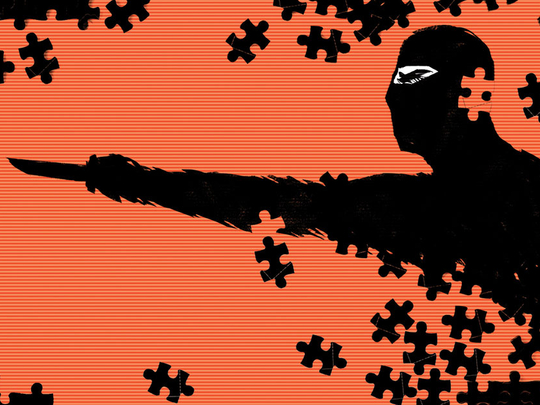
Many have tried, yet few have succeeded in deconstructing the history behind the rise of Daesh (Islamic State of Iraq and the Levant).
Concurrently, the constant injection of all sorts of bizarre arguments, like that of Graeme Wood’s recent piece in the Atlantic, is mostly aimed at creating distractions, blaming religion and its zealots for their “apocalyptic” view of the world.
“That the Islamic State [Daesh] holds the imminent fulfilment of prophecy as a matter of dogma at least tells us the mettle of our opponent. It is ready to cheer its own near-obliteration, and to remain confident, even when surrounded, that it will receive divine succour if it stays true to the Prophetic model,” Wood concluded with the type of liberal positivism that has become as galling as religious fervour.
While the “what does IS really want” argument will continue to be held hostage ideological diatribes and political manipulation, it is important to examine the argument from a relatively detached historical viewpoint.
From a people’s history (“history from below”) perspective, Daesh is at best, hard to explain, and at worst, beyond any comprehension.
True, at present, the Middle East region is the ideal incubator for violent militancy and political radicalisation. However, it is difficult to place Daesh even within that context without raising a host of questions.
Starting with the first US-led western war in Iraq (1990-91), then a decade-long blockade, then the invasion of Iraq (2003), the Middle East has undergone a rapid state of radicalisation that was more or less consistent with the violence visited upon the region by the US and its allies. Generation after generation of angry, radicalised, unemployed and humiliated youth was very much a reasonable and predictable outcome.
The so-called Arab Spring could have been the political platform to offer a positive outlet for change, to absorb the existing anger and channel it to reverse the tide of radicalisation, hopelessness and growing militarism. But that too was suffocated by the same traditional forces that engendered corruption and violence in the first place.
The “counter revolutions” backed by western military interventions remoulded the old reality, but in a much more violent and oppressive way than before. They created a vacuum that was naturally filled by non-state actors, sometimes tribes as in the case of Yemen, and partly in Libya — and other times by militant groups as is the case of Syria.
Most notorious among those is Daesh. But that is where the logic of the story begins to dissipate.
Regardless of how one is to explain the rise of Daesh from a historical point of view, one runs into too many limitations facing any existing argument.
People’s history is particular relevant here. It attempts to study certain political and other phenomena by examining the underlying circumstances of history that go beyond the intrigues, interests and conspiracies of competing elites. It looks at the lives of ordinary people, united by the most common historical denominators to explain collective occurrences in the past or present, and attempts to explore future possibilities.
Judging by the number of individuals we think might be involved in the formation of the group and their supposed outreach beyond certain geographical areas, Daesh could in theory be recognised as a collective phenomenon. Daesh members and supporters are heavily present in Iraq and Syria, but claim influence in other Middle Eastern regions including Sinai, Egypt, Libya and elsewhere.
In fact, they entered the Libyan scene, itself crowded with many militias and other violent manifestations, in a dramatic away by purportedly butchering 21 Egyptian labourers working in that war-torn North African country.
But a puzzling matter exists. While Al Qaida during its most violent phases won the support of many people in the region, Daesh is hardly popular. Even the support of Salafist militants here and there is diminishing.
Those who half-heartedly supported Daesh during the first phase of the Syria civil war quickly turned against them. Daesh was later accused of being a Syrian intelligence outlet, or at least working closely with the regime with the aim of breaking the ranks of the opposition. That theory was marginalised quickly as Daesh began butchering Syrian soldiers.
Still, Daesh is peculiarly growing; its tentacles are stretching further despite the declared US-led war to destroy it with the help of many powerful allies.
Daesh was arguably an outcome of various alliances that took place starting in Iraq 10 years ago, between Al Qaida and other regional groups; they didn’t appear as a serious force until recently. Yet, in the matter of two years or less, it managed to achieve what Al Qaida — which was much more popular for opposing the US and its allies — couldn’t achieve in nearly 15 years.
Within a matter of months, Daesh managed to claim and sustain its control over massive territorial gains in Syria but much more rapidly in Iraq, to operate a relatively functioning economy and to develop a most remarkable media apparatus. It even developed its own school curriculum.
From the notoriety of its methods, it seems that Daesh is little concerned about its own popularity among ordinary people, who are its ultimate victim. This has been demonstrated time and again, most notably in the killing of the Jordanian pilot, Muath Al Kaseasbeh.
While violence and war radicalise people, the size and nature of the Daesh phenomenon doesn’t seem consistent with its rational historical context.
Even the sectarianism argument rarely addresses the point. Daesh victims come from every class, religion, ethnicity, gender and political group.
Some find Daesh’s behaviour as a handy opportunity to bash Islam, to the puzzlement of most Muslims, who know full well that setting people ablaze goes against every value that Islam stands for. Even Al Qaida rejected Daesh, because of its brutal behaviour, which itself is telling.
Unlike Al Qaida, Daesh’s religious agenda is hardly as pronounced. They carry out all sorts of bizarre actions in the name of Islam, but seem to lack deep Islamic theology or forward thinking vision. They are intensely militaristic and their body of Islamic literature is selective and lacking. This is what was concluded by those who spent time with Daesh, expecting that the religious component would be the overriding element in their war.
Yet, without major popular backing, and removed from much of the historical context in the Middle East, they continue to grow, and appear in the most politically convenient locations.
This is not to propose a conspiracy or to purport to understand the exact dynamics that propel Daesh, but to raise questions: prominent among them is that Daesh’s mysterious roots, its sudden advent, massive growth, and unexplainable geopolitical expansion is inconsistent with the lack of enthusiasm for them and their cause among ordinary people.
In fact, if judged exclusively through the prism of people’s history, the Daesh phenomenon is ahistorical.
By exploring that assumption, Daesh can be better understood, and perhaps confronted. The answer does not lie in understanding either Islam or Muslims, but by following the money trail, regional intrigues, and obvious and not so-obvious competing political agendas.
Simply put, ordinary people are not the force behind Daesh. If we accept that hypothesis, we are likely to change the way we explain and think about Daesh altogether.
Ramzy Baroud is an internationally-syndicated columnist, a media consultant, an author of several books and the founder of PalestineChronicle.com. He is currently completing his PhD studies at the University of Exeter. His latest book is My Father Was a Freedom Fighter: Gaza’s Untold Story (Pluto Press, London).








